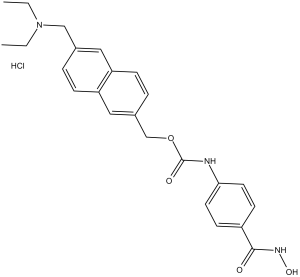Givinostat HCl
This product is for research use only, not for human use. We do not sell to patients.

For small sizes, please check our retail website as below: www.invivochem.com
| Size | Price | Stock |
|---|---|---|
| 250mg | $1240 | Check With Us |
| 500mg | $1750 | Check With Us |
| 1g | $2625 | Check With Us |
Cat #: V3844 CAS #: 199657-29-9 Purity ≥ 98%
Description: Givinostat (ITF-2357 hydrochloride) is a potent and orally bioactive HDAC inhibitor with potential anti-inflammatory, anti-angiogenic, and anticancer activities.
Top Publications Citing Invivochem Products
Publications Citing InvivoChem Products
Product Promise

- Physicochemical and Storage Information
- Protocol
- Related Biological Data
- Stock Solution Preparation
- Quality Control Documentation
| Molecular Weight (MW) | 457.96 |
|---|---|
| Molecular Formula | C24H27N3O4.HCl |
| CAS No. | 199657-29-9 |
| Storage | -20℃ for 3 years in powder formr |
| -80℃ for 2 years in solvent | |
| Solubility In Vitro | DMSO: >100 mg/mLr |
| Water: <1 mg/mLr | |
| Ethanol: 3 mg/mL | |
| Solubility In Vivo | 30% propylene glycol, 5% Tween 80, 65% D5W: 30 mg/mL |
| Synonyms | ITF-2357 HCl; ITF 2357; ITF2357; Givinostat HCl ; gavinostat; |
| Protocol | In Vitro | Givinostat (ITF2357) suppresses total LPS-induced IL-1β production robustly compared with the reduction by ITF3056. At 25, 50, and 100 nM, Givinostat reduces IL-1β secretion more than 70%. Givinostat suppresses the production of IL-6 in PBMCs stimulated with TLR agonists as well as the combination of IL-12 plus IL-18. IL-6 secretion decreases to 50% at 50 nM Givinostat, but at 100 and 200 nM, there is no reduction |
|---|---|---|
| In Vivo | Givinostat (ITF2357) at 10 mg/kg is used as a positive control and reduces serum TNFα by 60%. Pretreatment of Givinostat (ITF-2357) starting at 0.1 mg/kg significantly reduces the circulating TNFα by nearly 90%. To achieve a significant increase in serum IL-1β production, a higher dose of LPS is injected (10 mg/kg), and blood is collected after 4 h |
These protocols are for reference only. InvivoChem does not
independently validate these methods.
| Solvent volume to be added | Mass (the weight of a compound) | |||
|---|---|---|---|---|
| Mother liquor concentration | 1mg | 5mg | 10mg | 20mg |
| 1mM | 2.1836 mL | 10.9180 mL | 21.8360 mL | 43.6719 mL |
| 5mM | 0.4367 mL | 2.1836 mL | 4.3672 mL | 8.7344 mL |
| 10mM | 0.2184 mL | 1.0918 mL | 2.1836 mL | 4.3672 mL |
| 20mM | 0.1092 mL | 0.5459 mL | 1.0918 mL | 2.1836 mL |
The molarity calculator equation
Mass(g) = Concentration(mol/L) × Volume(L) × Molecular Weight(g/mol)
Mass
=
Concentration
×
Volume
×
Molecular Weight*
The dilution calculator equation
Concentration(start)
×
Volume(start)
=
Concentration(final)
×
Volume(final)
This equation is commonly abbreviated as: C1 V1 = C2 V2
Concentration(start)
C1
×
Volume(start)
V1
=
Concentration(final)
C2
×
Volume(final)
V2
Step One: Enter information below
Dosage mg/kg
Average weight of animals g
Dosing volume per animal µL
Number of animals
Step Two: Enter the in vivo formulation
%DMSO
+
%
+
%Tween 80
+
%ddH2O
Calculation Results:
Working concentration:
mg/ml;
Method for preparing DMSO master liquid:
mg
drug pre-dissolved in
µL
DMSO(Master liquid concentration
mg/mL)
,Please contact us first if the concentration exceeds the DMSO solubility of the batch of drug.
Method for preparing in vivo formulation:
Take
µL
DMSO master liquid, next add
µL
PEG300, mix and clarify, next add
µL
Tween 80,mix and clarify, next add
µL
ddH2O,mix and clarify.
Note:
- (1) Please be sure that the solution is clear before the addition of next solvent. Dissolution methods like vortex, ultrasound or warming and heat may be used to aid dissolving.
- (2) Be sure to add the solvent(s) in order.




































